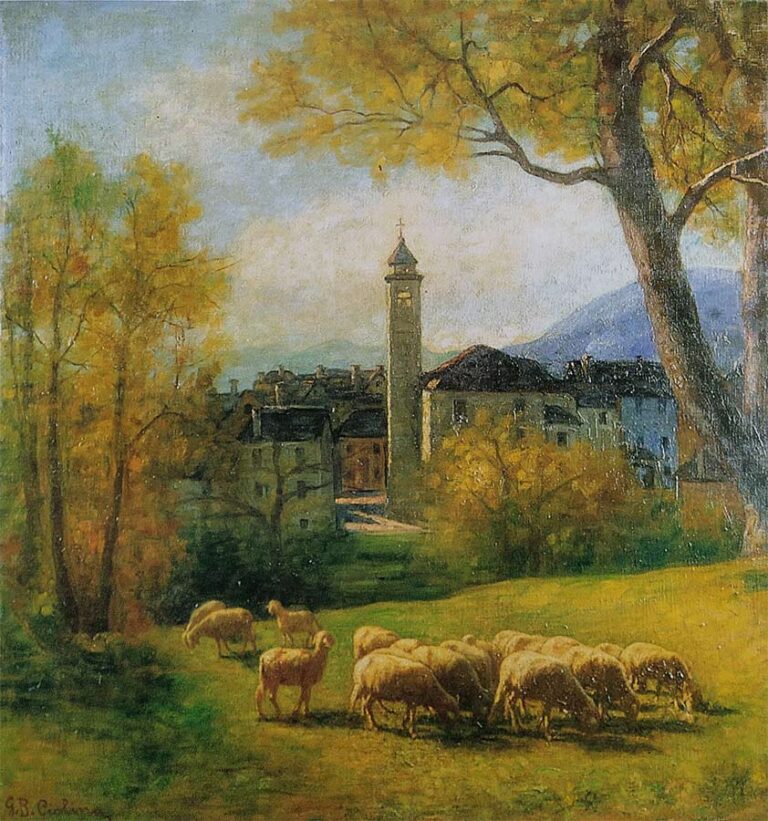The warmth of those sunbeams, rendered slightly golden by the light mist that is often seen in the first days of spring, never fails to remind me of my dear homeland, those beautiful places where the sun shines clear and pure over the virgin, majestic Alps. It is a beautiful morning; in distant bell towers, scattered here and there in the cities, other music can be heard, which harmonises wonderfully with the general atmosphere, the hour, the country, the sky, the sun and the season, forming a single melancholic harmony that resonates deeply within the soul. (…) Impressions should not be avoided; on the contrary they should be sought after and embraced fully; sustained with a strong spirit, so that they leave no harmful trace within oneself.
March-April 1896. Giovanni Battista Ciolina’s diaries. Transcribed by Paolo Ciolina



CRITICAL ANALYSIS
Giovanni Battista Ciolina had to travel along the mule track that descends from Toceno to Santa Maria Maggiore countless time as a young boy, starting when he attended classes at the Rossetti Valentini School of Fine Arts, learning under the guidance of Enrico Cavalli. However, this did not stop him from being inspired by his familiar surroundings, especially in the variations in light and atmosphere that Cavalli taught him to depict through an evocative rather than descriptive brushstroke technique. Ignoring the rigour of realistic representation, he relied on the use of colour rather than the precision of drawing. There is no doubt that Campanile di Crana al tramonto (The Crana Belltower at Sunset) is a mature work, yet in it Ciolina clearly demonstrates the lingering influence of Cavalli’s teachings, which were strongly connected to the painting style of Adolphe Monticelli, who was a fundamental reference for the young students.
The bold, broad brushstrokes do not describe in minute detail a subject that Ciolina knew so well that he didn’t need to paint it from real life, but rather they suggest it through the frame of the tree in the foreground and the bell tower in the background, which are the only immediately recognisable elements. The rest is an almost free succession of solid brushstrokes in which colour takes centre stage. Simultaneously, through contrasts set on a warm brownish-yellow base, Ciolina manages to depict the enveloping light of an autumnal Vigezzo Valley sunset with unparalleled poetry. His use of purple among the branches of the tree is masterful in evoking the village houses, reduced to shadowy masses in the twilight. This is further enhanced by touches of pink and green in the sky, which convey a sense of the clarity of the Alpine air. It must inevitably be compared with Campanile di Crana, (The Crana Belltower), a sketch whose incompleteness does not detract from the effectiveness of a scene centred around the church peeping through the trees, with its bell tower reaching towards an intensely blue sky. Here, the brushstrokes are also applied constructively, and are even more imposing in their ability to reveal the preparation of the canvas. The contrast between tones manages to produce a light that, rather than reflecting the sky, seems to emanate directly from the objects at an indeterminate hour of the day, capturing an inner sensation rather than a realistic representation.
Pecore al pascolo a Crana (Sheep Grazing in Crana) has quite a different character. Its almost photographic rendering, which is reassuring in its calm, immediately reveals it to be a piece of artwork intended for sale. Permeated by a soft, warm light in shades of yellow, it plays with the backlight of the afternoon sun in late autumn, highlighting the small flock in the foreground and filtering through to enhance the leafy branches of the tree on the left. A thick, textured brushstroke dominates the painting, leaving room for a more constructive stroke in the background tree at the centre, achieving a vibrant luminosity that was so dear to the Divisionists, and that Ciolina accomplished with an entirely different technique.
Critical analysis by Paolo Volorio.
Text and image research and adaptation by Chiara Besana.
Sign up to receive news on events, exhibitions and trainings from the Rossetti Valentini School of Fine Arts Foundation.
Iscriviti per ricevere le news su eventi, mostre, incontri di formazione organizzati dalla Fondazione Scuola di Belle Arti Rossetti Valentini.